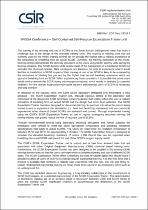JavaScript is disabled for your browser. Some features of this site may not work without it.
- ResearchSpace
- →
- Research Publications/Outputs
- →
- Conference Publications
- →
- View Item
| dc.contributor.author |
Sehlabana, Matome M

|
|
| dc.date.accessioned | 2018-10-05T10:22:18Z | |
| dc.date.available | 2018-10-05T10:22:18Z | |
| dc.date.issued | 2018-05 | |
| dc.identifier.citation | Sehlabana, M.M. 2018. Self-contained self-rescuer expectation trainer unit. The Mine Ventilation Society Of South Africa Conference 2018, Emperors Palace, Johannesburg, 31 May 2018-1 June 2018 | en_US |
| dc.identifier.uri | http://hdl.handle.net/10204/10438 | |
| dc.description | Paper presented during the Mine Ventilation Society Of South Africa Conference 2018, Emperors Palace, Johannesburg, 31 May 2018-1 June 2018 | en_US |
| dc.description.abstract | The deployment of self-contained self-rescuers (SCSRs) together with the location of the refuge bays is part of well devised emergency evacuation procedures. For these to be successful, workers have to conversant with and should be well schooled in the use of this equipment by means of requisite training material and through continual re-training and assessment. Unfortunately, a number of underground incidents that resulted in the tragic death of miners have indicated that, despite this equipment and systems being available, workers' response such tense and stressful situations may be less than adequate. Analysis of findings from these events indicate the need to improve the nature and level of miner training in escape and rescue operations to ensure the correct use of SCSRs once donned and in particular to expose miners to the physical conditions which they will experience once the SCSR is activated. This paper explores the possibility of improving current training methodologies beyond the current "show-and-tell" procedures based on original equipment manufacturers' user manuals. The requirement is for training procedures that will provide an indication of physical, cognitive, psychological stressors and behavioural responses that are likely to be experienced in such situations. Experiential training has been adopted in the United States to subject workers to the more practical aspects of donning a SCSR and of escaping in an underground environment while affording and opportunity to experience conditions that closely resemble those that would be encountered in reality. This paper also provides an insight into the experiential trainer being developed currently by the CSIR as an instrument that will facilitate the experiential section of such training, using a simply activated, portable device that will provide the opportunity for every trainee to experience a such conditions in a healthy and safe environment. | en_US |
| dc.language.iso | en | en_US |
| dc.relation.ispartofseries | Worklist;21399 | |
| dc.subject | Self-contained self-rescuers | en_US |
| dc.subject | SCSR | en_US |
| dc.subject | Training device | en_US |
| dc.subject | Expectation training | en_US |
| dc.subject | SAM expectation trainer | en_US |
| dc.title | Self-contained self-rescuer expectation trainer unit | en_US |
| dc.type | Conference Presentation | en_US |
| dc.identifier.apacitation | Sehlabana, M. M. (2018). Self-contained self-rescuer expectation trainer unit. http://hdl.handle.net/10204/10438 | en_ZA |
| dc.identifier.chicagocitation | Sehlabana, Matome M. "Self-contained self-rescuer expectation trainer unit." (2018): http://hdl.handle.net/10204/10438 | en_ZA |
| dc.identifier.vancouvercitation | Sehlabana MM, Self-contained self-rescuer expectation trainer unit; 2018. http://hdl.handle.net/10204/10438 . | en_ZA |
| dc.identifier.ris | TY - Conference Presentation AU - Sehlabana, Matome M AB - The deployment of self-contained self-rescuers (SCSRs) together with the location of the refuge bays is part of well devised emergency evacuation procedures. For these to be successful, workers have to conversant with and should be well schooled in the use of this equipment by means of requisite training material and through continual re-training and assessment. Unfortunately, a number of underground incidents that resulted in the tragic death of miners have indicated that, despite this equipment and systems being available, workers' response such tense and stressful situations may be less than adequate. Analysis of findings from these events indicate the need to improve the nature and level of miner training in escape and rescue operations to ensure the correct use of SCSRs once donned and in particular to expose miners to the physical conditions which they will experience once the SCSR is activated. This paper explores the possibility of improving current training methodologies beyond the current "show-and-tell" procedures based on original equipment manufacturers' user manuals. The requirement is for training procedures that will provide an indication of physical, cognitive, psychological stressors and behavioural responses that are likely to be experienced in such situations. Experiential training has been adopted in the United States to subject workers to the more practical aspects of donning a SCSR and of escaping in an underground environment while affording and opportunity to experience conditions that closely resemble those that would be encountered in reality. This paper also provides an insight into the experiential trainer being developed currently by the CSIR as an instrument that will facilitate the experiential section of such training, using a simply activated, portable device that will provide the opportunity for every trainee to experience a such conditions in a healthy and safe environment. DA - 2018-05 DB - ResearchSpace DP - CSIR KW - Self-contained self-rescuers KW - SCSR KW - Training device KW - Expectation training KW - SAM expectation trainer LK - https://researchspace.csir.co.za PY - 2018 T1 - Self-contained self-rescuer expectation trainer unit TI - Self-contained self-rescuer expectation trainer unit UR - http://hdl.handle.net/10204/10438 ER - | en_ZA |






